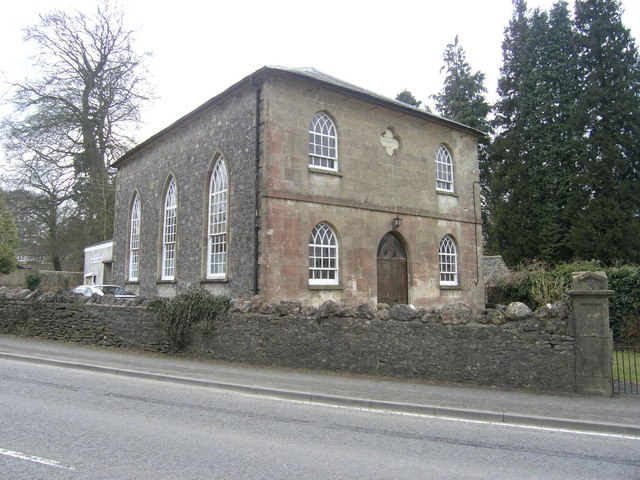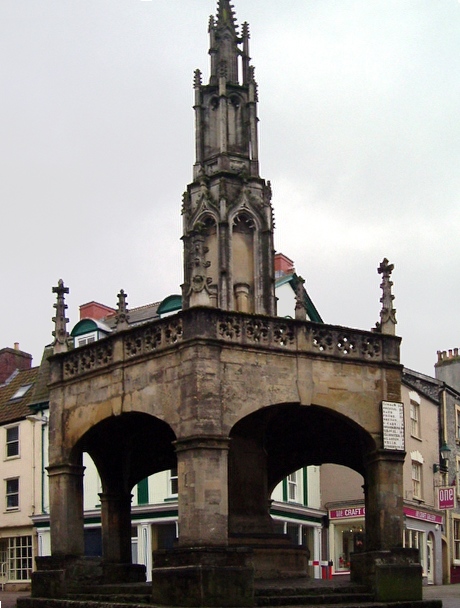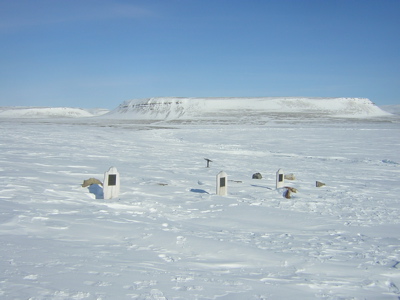|
Oakhill
Oakhill is a village in the Mendip district of Somerset, England, in Ashwick parish approximately north of Shepton Mallet. It lies between the A37 and the A367 (which is part of the ancient Fosse Way). Oakhill is today is mainly a commuter village of in size, and is notable for former activities which including brewing. The village contains a Church of England primary school and a surgery, as well as a public house, the Oakhill Inn. Little London is the name given to a cluster of houses at the western end of the village. It is sometimes referred to by tradespeople etc. as a settlement in itself for the purpose of location, because of the elongated character of the village. History A brewing industry led to the growth of the village, and as a result a parish church, All Saints, was built in 1861 to a design by J. L. Pearson to provide a place of worship for the inhabitants, who previously had belonged to the parishes of Ashwick or Shepton Mallet, the boundary between which ... [...More Info...] [...Related Items...] OR: [Wikipedia] [Google] [Baidu] |
Shepton Mallet
Shepton Mallet is a market town and civil parish in the Mendip District of Somerset, England, some south-west of Bath, south of Bristol and east of Wells. It had an estimated population of 10,810 in 2019. Mendip District Council is based there. The Mendip Hills lie to the north and the River Sheppey runs through the town, as does the route of the Fosse Way, the main Roman road between north-east and south-west England. There is evidence of Roman settlement. Its listed buildings include a medieval parish church. Shepton Mallet Prison was England's oldest, but closed in March 2013. The medieval wool trade gave way to trades such as brewing in the 18th century. It remains noted for cider production. It is the closest town to the Glastonbury Festival and nearby the Royal Bath and West of England Society showground. History Etymology The name Shepton derives from the Old English ''scoep'' and ''tun'', meaning "sheep farm"; the ''Domesday Book'' of 1086 records a settlement kn ... [...More Info...] [...Related Items...] OR: [Wikipedia] [Google] [Baidu] |
Oakhill Brewery
Oakhill Brewery was a brewery in Oakhill, Somerset, England, that was founded in 1761 by John Billingsley (agriculturist), John Billingsley. History In its heyday the Oakhill Brewery was a major producer, known for Oakhill Invalid Stout. In 1904, due to its volume of production – between 2,000 and 2,500 barrels per week – the brewery constructed its own Narrow gauge railway, narrow gauge railway to take barrels of Oakhill Invalid Stout to the Somerset & Dorset Railway in nearby Binegar. Until the railway's construction, the brewery had used a Wallis & Steevens traction engine to deliver their barrels to the station. Production continued at the brewery until the advent of World War I sent it into decline. The brewery was destroyed by fire in 1924, and subsequently taken over by Courage Brewery. Although brewing stopped in 1938, the malt sheds remained in use. Beacon Brewery In 1981 brewing resumed in the former Oakhill Brewery building when Beacon Brewery took over the premise ... [...More Info...] [...Related Items...] OR: [Wikipedia] [Google] [Baidu] |
Ashwick
Ashwick is a village in the Mendip district of Somerset, England, about three miles north of Shepton Mallet and seven miles east from Wells. It has also been a civil parish since 1826. The parish had a population of 1,352 according to the 2011 census, and apart from Ashwick village also includes Gurney Slade and Oakhill. History The area around Ashwick has evidence of occupation since the Iron Age, being in close proximity to Maesbury Castle. In Roman Britain, Fosse Way was constructed, which passes to the east of the parish. Although Oakhill is the larger village today, Ashwick is the older settlement, dating back to Anglo-Saxon times. It appears in the Domesday book as a settlement called Escewiche, which translates as 'the hamlet or farmstead by the ash trees'. The parish of Ashwick was part of the Hundred of Kilmersdon. The village is the site of Ashwick Court, a country house dating from the late 17th century and Grade II* listed. Anthony Newley's short-lived 1960 ATV ... [...More Info...] [...Related Items...] OR: [Wikipedia] [Google] [Baidu] |
William Braine
William Braine (1814 – 3 April 1846) was a British explorer. He served as a marine in the Royal Marines. From 1845 he was part of an expedition to find the Northwest Passage, but he died early in the trip and was buried on Beechey Island. His preserved body was exhumed in 1984, to try to determine the cause of death. Early life William Braine was born in Oakhill, Somerset in 1814, and enlisted in the Royal Marines during the 1830s. He was assigned to HMS Erebus during Franklin's Lost Expedition. 1845 Franklin expedition Braine was a part of Sir John Franklin's final expedition to find the Northwest Passage. The trip was expected to last about three years, so the ships were packed with provisions which included more than 136,000 pounds of flour, 3,684 gallons of high-proof alcohol and 33,000 pounds of tinned meat, soup and vegetables. Death Braine died ten months into the expedition, and was buried on Beechey Island with John Torrington and John Hartnell. He died last, and h ... [...More Info...] [...Related Items...] OR: [Wikipedia] [Google] [Baidu] |
John Billingsley (agriculturist)
John Billingsley (1747–1811) was an agricultural pioneer in 18th century Somerset, England. The writer of the 1794 Survey of Somerset, Billingsley was a leading agriculturalist who was one of the founders of the Bath and West Society, known today as the Royal Bath and West of England Society. He lived all his life at Ashwick Grove. Family life He was born in 1747, the grandson of Nicholas Billingsley, a Presbyterian dissenter who was minister at Ashwick from 1699 to 1729. Little is known about his early life but by 1782, he was listed as Brewer along with Ryan Gosling of the Oakhill Brewery in the neighbouring village of Oakhill, and may have been involved in the wool trade before that. He was described as a leading member of the Presbyterian church although at some stage he was reconciled with the Church of England. ''General View of the Agriculture of the County of Somerset'' The 18th century was largely one of peace in Somerset, but the Industrial Revolution in th ... [...More Info...] [...Related Items...] OR: [Wikipedia] [Google] [Baidu] |
Fosse Way
The Fosse Way was a Roman road built in Britain during the first and second centuries AD that linked Isca Dumnoniorum (Exeter) in the southwest and Lindum Colonia (Lincoln) to the northeast, via Lindinis (Ilchester), Aquae Sulis ( Bath), Corinium (Cirencester), and Ratae Corieltauvorum (Leicester). Roman route The word ''Fosse'' is derived from the Latin , meaning 'ditch'. For the first few decades after the Roman invasion of Britain in 43 CE, the Fosse Way marked the western frontier of Roman rule in Iron Age Britain. It is possible that the road began as a defensive ditch that was later filled in and converted into a road, or possibly a defensive ditch ran alongside the road for at least some of its length. The road joined Akeman Street and Ermin Way at Cirencester, crossed Watling Street at ''Venonis'' (High Cross) south of Leicester, and joined Ermine Street at Lincoln. The Antonine Itinerary (a 2nd-century Roman register of roads) includes the section between High Cross ... [...More Info...] [...Related Items...] OR: [Wikipedia] [Google] [Baidu] |
Mendip District
Mendip is a local government district of Somerset in England. The district covers a largely rural area of with a population of approximately 112,500, ranging from the Wiltshire border in the east to part of the Somerset Levels in the west. The district takes its name from the Mendip Hills which lie in its northwest. The administrative centre of the district is Shepton Mallet but the largest town (three times larger than Shepton Mallet) is Frome. The district was formed on 1 April 1974 under the Local Government Act 1972, by a merger of the municipal boroughs of Glastonbury and Wells, along with Frome, Shepton Mallet, Street urban districts, and Frome Rural District, Shepton Mallet Rural District, Wells Rural District, part of Axbridge Rural District and part of Clutton Rural District. On 1 April 2023, the district will be abolished and replaced by a new unitary district for the area at present served by Somerset County Council. The new council will be known as Somerset C ... [...More Info...] [...Related Items...] OR: [Wikipedia] [Google] [Baidu] |
Northwest Passage
The Northwest Passage (NWP) is the sea route between the Atlantic and Pacific oceans through the Arctic Ocean, along the northern coast of North America via waterways through the Canadian Arctic Archipelago. The eastern route along the Arctic coasts of Norway and Siberia is accordingly called the Northeast Passage (NEP). The various islands of the archipelago are separated from one another and from Mainland Canada by a series of Arctic waterways collectively known as the Northwest Passages, Northwestern Passages or the Canadian Internal Waters. For centuries, European explorers, beginning with Christopher Columbus in 1492, sought a navigable passage as a possible trade route to Asia, but were blocked by North, Central, and South America, by ice, or by rough waters (e.g. Tierra del Fuego). An ice-bound northern route was discovered in 1850 by the Irish explorer Robert McClure. Scotsman John Rae explored a more southerly area in 1854 through which Norwegian Roald Amundsen f ... [...More Info...] [...Related Items...] OR: [Wikipedia] [Google] [Baidu] |
Franklin's Lost Expedition
Franklin's lost expedition was a failed British voyage of Arctic exploration led by Captain Sir John Franklin that departed England in 1845 aboard two ships, and , and was assigned to traverse the last unnavigated sections of the Northwest Passage in the Canadian Arctic and to record magnetic data to help determine whether a better understanding could aid navigation. The expedition met with disaster after both ships and their crews, a total of 129 officers and men, became icebound in Victoria Strait near King William Island in what is today the Canadian territory of Nunavut. After being icebound for more than a year ''Erebus'' and ''Terror'' were abandoned in April 1848, by which point Franklin and nearly two dozen others had died. The survivors, now led by Franklin's second-in-command, Francis Crozier, and ''Erebus''s captain, James Fitzjames, set out for the Canadian mainland and disappeared, presumably having perished. Pressed by Franklin's wife, Jane, and others, t ... [...More Info...] [...Related Items...] OR: [Wikipedia] [Google] [Baidu] |
Locomotive
A locomotive or engine is a rail transport vehicle that provides the Power (physics), motive power for a train. If a locomotive is capable of carrying a payload, it is usually rather referred to as a multiple unit, Motor coach (rail), motor coach, railcar or power car; the use of these self-propelled vehicles is increasingly common for passenger trains, but rare for freight (see CargoSprinter). Traditionally, locomotives pulled trains from the front. However, Push-pull train, push-pull operation has become common, where the train may have a locomotive (or locomotives) at the front, at the rear, or at each end. Most recently railroads have begun adopting DPU or distributed power. The front may have one or two locomotives followed by a mid-train locomotive that is controlled remotely from the lead unit. __TOC__ Etymology The word ''locomotive'' originates from the Latin language, Latin 'from a place', Ablative case, ablative of 'place', and the Medieval Latin 'causing mot ... [...More Info...] [...Related Items...] OR: [Wikipedia] [Google] [Baidu] |
Binegar Railway Station
Binegar railway station was a station on the Somerset and Dorset Joint Railway in the county of Somerset in England. Opened on 20 July 1874, the station consisted of two platforms, with a building on the down platform. There was a substantial goods yard with two sheds and sidings, controlled from a 24 lever signal box In signal processing, a signal is a function that conveys information about a phenomenon. Any quantity that can vary over space or time can be used as a signal to share messages between observers. The ''IEEE Transactions on Signal Processing'' .... Being the first station north of the line's summit at Masbury Binegar was also where locomotives used as banking engines on north-bound trains would drop off and cross the line ready to return south. The station closed to goods in 1963: passenger services were withdrawn when the SDJR closed on 7 March 1966. Accident There were several fatalities in two accidents near this station in the 1880 The site today The ... [...More Info...] [...Related Items...] OR: [Wikipedia] [Google] [Baidu] |
Somerset & Dorset Railway
The Somerset and Dorset Joint Railway, also known as the S&D, SDJR or S&DJR, was an English railway line connecting Bath (in north-east Somerset) and Bournemouth (now in south-east Dorset but then in Hampshire), with a branch from Evercreech Junction to Burnham-on-Sea and Bridgwater. Strictly speaking, the main line ran from Bath Junction to Broadstone, as the line between Broadstone and Bournemouth was owned by the London and South Western Railway, while the line between Bath Junction and Bath was owned by the Midland Railway. The line was used for freight and local passenger traffic over the Mendip Hills, and for weekend holiday traffic to Bournemouth. Criticised as the "Slow and Dirty" or the "Slow and Doubtful", it closed in 1966 as part of the Beeching axe despite protests from the local community. Overview The Somerset and Dorset Railway (S&D) was created in 1862, as an amalgamation of the Somerset Central Railway and the Dorset Central Railway. By the followin ... [...More Info...] [...Related Items...] OR: [Wikipedia] [Google] [Baidu] |










